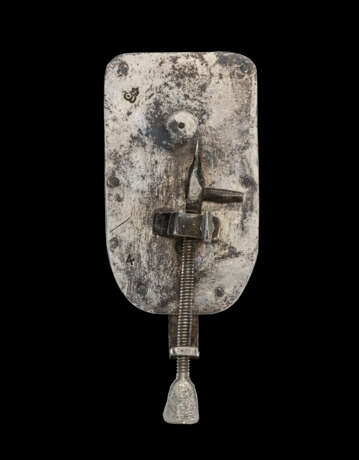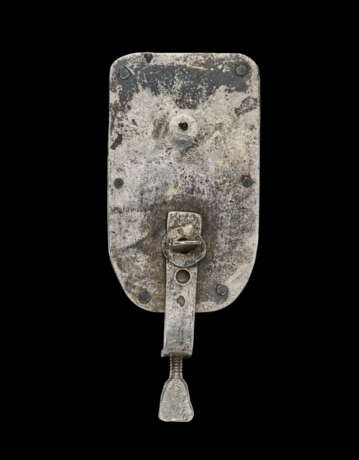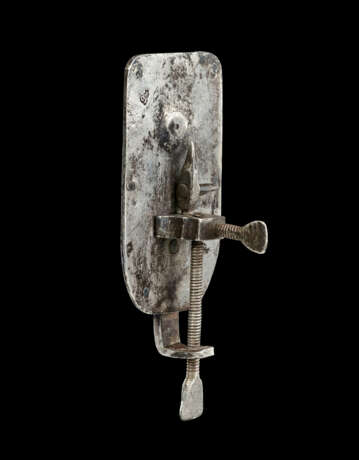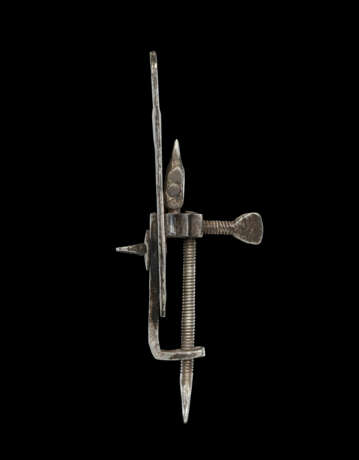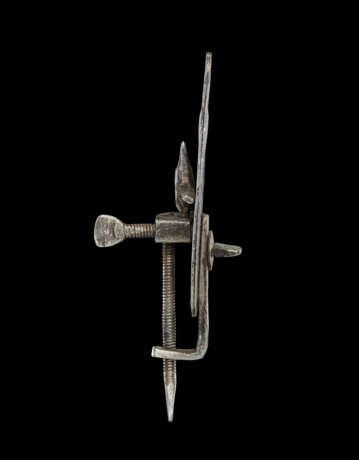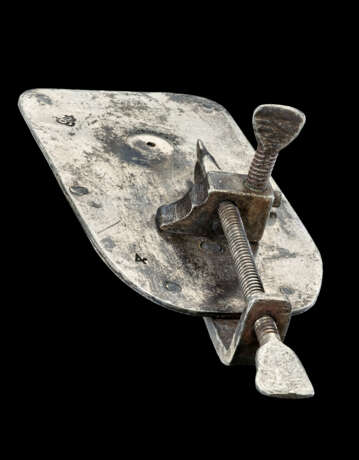ID 1105643
Lot 52 | Antoni van Leeuwenhoek (1632–1723)
Estimate value
£ 150 000 – 250 000
A silver microscope
One of the rarest microscopes by the father of microbiology, with the highest magnification extant.
The lens held between two riveted silver plates (41 x 24mm.) achieving a magnification of approximately 285x ; stage with rounded step design, specimen pin and focusing screw; main screw with wedged wing-handle, the angle bracket with two settings for securing screw and washer. Patinated with a selenium agent and later polished. Marked with an engraved '4', and later Dutch assay marks for 1807, 1809-14 and 1814-31. 2¼ x 1 x ¾in. (5.8 x 2.4 x 2.1cm.)
Antoni van Leeuwenhoek, born in Delft in 1632 at the height of the Golden Age of the Dutch Republic, was the son of a wealthy middle-class merchant. After receiving a basic education, he was apprenticed to a linen-draper, when he presumably gained his first experience of microscopy by using a magnifying-glass to examine fabrics, and later learned to grind lenses and construct simple microscopes. In 1676 a letter announcing the 1675 discovery of ‘’little Animals" living in rainwater was translated from Dutch into English (Leeuwenhoek spoke only Dutch) and published in the Royal Society's Philosophical Transactions. In all over one hundred communications of the Dutch microscopist were published by the Royal Society, who elected him a Fellow in 1680. Acknowledged as the father of microbiology, Leeuwenhoek discovered micro-organisms, and was the first to observe muscle fibres, bacteria and spermatozoa using his handcrafted microscopes.
A silver mark of a ' flowered v' is seen twice on the microscope. This was used for taxation in the Netherlands on foreign and old small objects of silver or gold and ultimately confirms that the microscope was in the Netherlands between 1814 and 1831. Further hallmarks are one used briefly in 1807, a ‘crowned O’, which overlapped by an ‘&’ used in the Southern Netherlands (now Belgium) from 1809-1814. The importance of these hallmarks is that they place the microscope in its country of manufacture in the early 19th century, at least 70 years before the first facsimile microscopes were made by the prominent member of both the Queckett Microscopical Club and the Royal Microscopical Society, John Mayall.
The wings on the threaded screws are a slightly different shape to the other known microscopes by Leeuwenhoek, where this places the current microscope in the chronology of his instrument making may never be known: there is no consensus on how he adapted his design over his 50 years of activity. The presence of an engraved ‘4’ in the corner of the plate suggest the previously unidentified mark is indeed a ’3’ on the Maitland/Artis copy (sold Christie’s South Kensington, 8 April 2009, lot 88). The significance of these numbers is not known, but has precedent in the copies described by Martin Folkes in 1737 as being in cases numbered 15-27.
Leeuwenhoek presented two of his microscopes to Queen Mary of England and Czar Peter 'The Great' of Russia, and gifted 26 of his silver microscopes to the Royal Society (now lost).
The discovery of a second silver Leeuwenhoek microscope in the UK in the last decade might at first be suggestive of the reappearance of the lost Royal Society set, but the hallmarks placing both in the Netherlands at a point in 1814-31 would rule that out. In all he is thought to have made over 322 microscopes, and a further 237 lenses. Most of these are recorded in the 1747 auction of his daughter Maria’s estate. Alas their survival rate has not been high. Only nine were known to be extant in 1983 for the exhibition held jointly at the Boerhaave and London Science Museums, Beads of glass. Since then three others have been discovered and are now in the collections of: the Boerhaave Museum; the Planetarium Zuylenburg collection; and the Camacho collection. This microscope is an important thirteenth addition to Leeuwenhoek’s oeuvre, and boasts the most high powered lens to survive.
| Address of auction |
CHRISTIE'S 8 King Street, St. James's SW1Y 6QT London United Kingdom | ||||
|---|---|---|---|---|---|
| Preview |
| ||||
| Phone | +44 (0)20 7839 9060 | ||||
| Buyer Premium | see on Website | ||||
| Conditions of purchase | Conditions of purchase |
